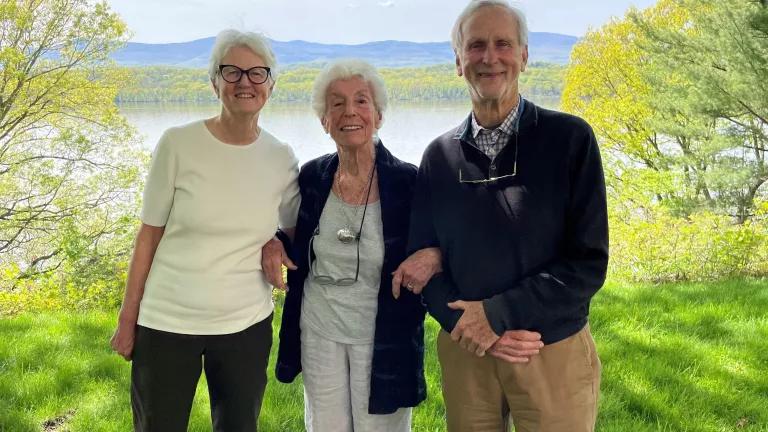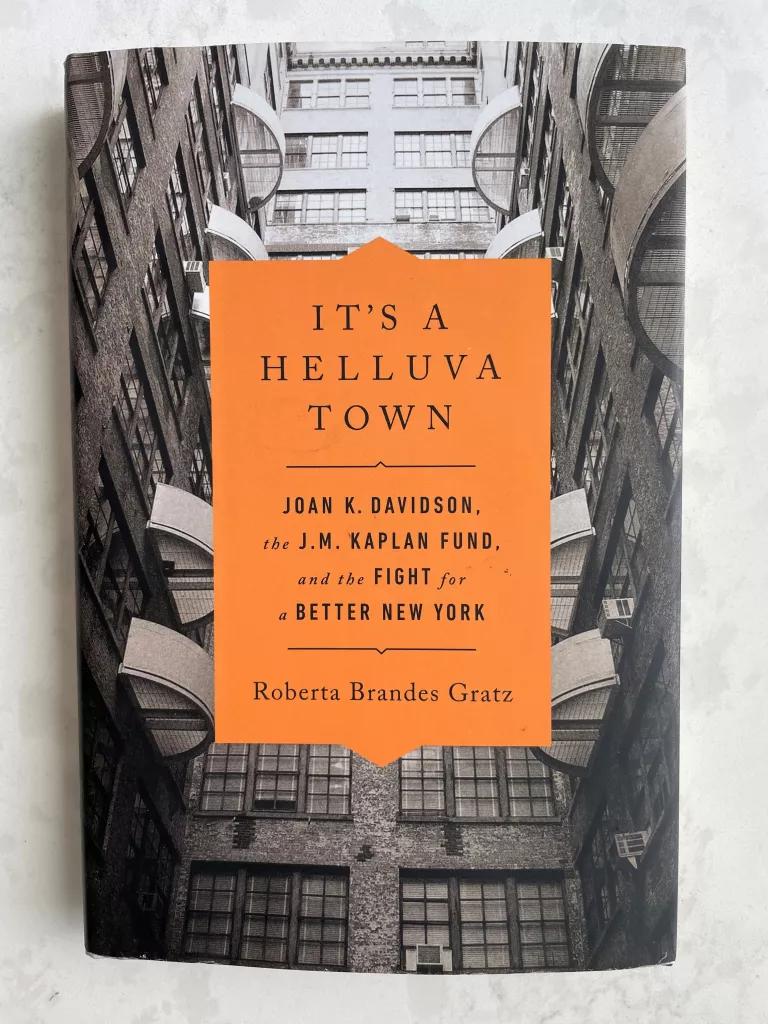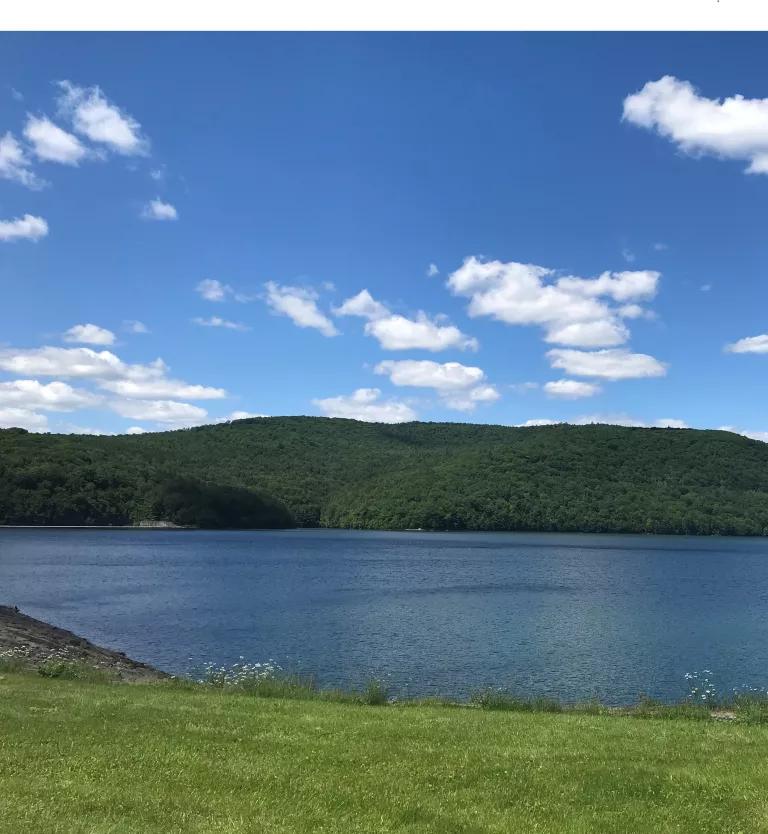Joan K. Davidson: An Appreciation
The longtime head of the J.M. Kaplan Fund was a visionary supporter of civic-minded advocates and a spark plug for creative environmental progress.

Joan Davidson (center), earlier this year, stands with former NRDC presidents Frances Beinecke and John H. Adams overlooking the Hudson River.
Eric A. Goldstein/NRDC
Joan K. Davidson, the longtime head of the J.M. Kaplan Fund who passed away earlier this month at age 96, was a visionary supporter of civic-minded advocates from all walks of life, a role model for women of valor, and a spark plug for creative environmental progress across New York State.
She was also an early and anchoring member of NRDC’s Board of Trustees, a generous supporter of our New York regional team, and a friend, advisor, and inspiration to many staff members—myself included.
Joan’s interests and influence were wide-ranging, but she was particularly committed to her hometown, New York City. She helped countless nonprofit organizations, large and small, defend the urban environment in its broadest sense.
Joan and the Kaplan Fund were early and steadfast supporters of Marcy Benstock’s Clean Air Campaign, the citizens’ group that led the public campaign to defeat the Westway highway boondoggle on Manhattan’s West Side. The proposed $1.6 billion, six-lane interstate highway was slated to be buried in new landfill that would have stretched 600 to 900 feet into the Hudson River from the Battery to 42nd Street.
The fact that virtually the entire political establishment was supporting the Westway development scheme didn’t discourage Joan from providing critical funding and support for the grassroots opposition. Following successful litigation, spearheaded by attorney Al Butzel on behalf of project opponents, city and state officials threw in the towel in 1985; they abandoned the superhighway idea and “traded in” the available federal highway funding for hundreds of millions of dollars to begin rebuilding the city’s beleaguered public transit system instead.
Joan also did much to create, improve, and enhance New York City’s parks. As described in detail in Roberta Brandes Gratz’s wonderful book on the history of the J.M. Kaplan Fund, It’s a Helluva Town, Joan provided funding for the hiring of the first Central Park administrator and played a formative role in the creation of the Central Park Conservancy, a successful public-private partnership that has been replicated to jump-start the revitalization of urban parklands near and far.

Author and urban expert Roberta Gratz has written a sweeping history of the J.M. Kaplan Fund that Joan Davidson headed for many years.
Eric A. Goldstein/NRDC
But it wasn’t just the crown jewel parks that received attention from Joan. Under her leadership, the Kaplan Fund supported Council on the Environment of New York City (now GrowNYC) Greenmarkets, as well as local parks and civic groups in all five boroughs.
Joan was a champion of historic preservation too. While she understood that change was inevitable and often positive, she and the Kaplan Fund buttressed those seeking to preserve the historic structures that are so important to the soul and character of the city. Joan was an early and fervent supporter of the successful campaign to save the South Street Seaport from the wrecking ball. She was knee-deep in the creative effort to preserve former industrial buildings along Manhattan’s lower West Side and transform them into Westbeth affordable housing for artists and their families. And she was instrumental in the fight to preserve two beloved, historic Broadway theaters—the Helen Hayes and the Morosco.
Those two theaters were ultimately razed in 1982, replaced by the undistinguished Marriott Marquis hotel. But the public high-visibility fight that Joan and the theater community engaged in led the Landmarks Preservation Commission to designate more than two dozen remaining theaters as landmarks. When theater owners sued to block these designations, Joan and the Kaplan Fund recruited and provided funding for NRDC to wage a successful court battle to uphold the commission’s action. (That case was litigated by attorney Mitch Bernard, who had worked with Butzel in the Westway fight. It was Joan’s good judgment that first brought Bernard, now NRDC’s chief counsel, into our organization.)

Joan was instrumental in bringing together NRDC, Riverkeeper, and other environmental groups in the innovative campaign to safeguard New York City’s upstate reservoirs.
Eric A. Goldstein/NRDC
What is less well known was Joan’s pivotal role in spearheading the environmental group effort to safeguard New York City’s priceless and irreplaceable upstate drinking water supply. In 1990, the city was facing the possibility of having to construct multibillion-dollar, energy-gobbling filtration facilities for the six giant Catskill reservoirs that provide nearly a billion gallons a day of water to nine million downstate residents.
Joan gathered a group of us—including NRDC, Riverkeeper, and New York City Department of Environmental Protection’s then commissioner Albert Appleton—and hatched the campaign for a less costly and more environment-friendly approach. We then worked together to keep pollution out of the reservoirs in the first place, via comprehensive watershed protection.
Joan and the Kaplan Fund were the first and most steadfast funders of this NGO effort. Without her personal support, NRDC, Riverkeeper, and our allies could never have built the expertise or stayed on the case through the years of implementation challenges.
Today—with dozens of pollution prevention and control measures in place and more than 140,000 acres of watershed lands protected—New York City’s successful watershed program stands as a national model.
So often, on the worthy causes that are important to New York City life (and the Empire State, more generally), Joan was quick to see and understand the problem, envision a potential solution, and wade in with early funding that unleashed a thoughtful and dogged activists’ response.
She was courageous and visionary, modest and gracious. And she was sure to credit the staff of the J.M. Kaplan Fund—including Ann Birckmayer, Suzanne Davis, Amy Freitag, Henry Ng, and Tony Wood—as well as the many groups and organizations she funded, for the successes she catalyzed.
Her many friends throughout New York City’s nonprofit community (and beyond) are grateful for her friendship and support and agree that Joan’s was a life well lived.




